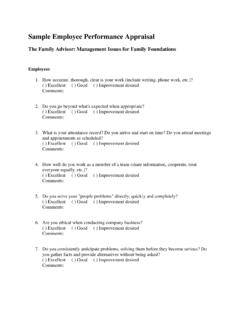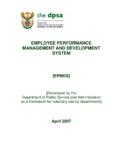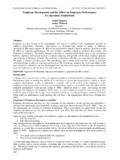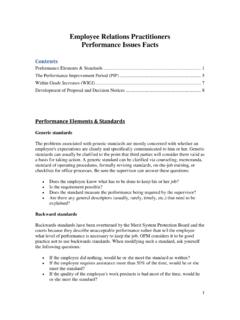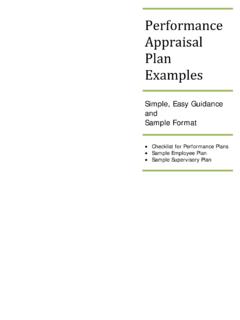Transcription of Career Development and Performance Appraisal: It Takes …
1 Reprinted from Personnel Magazine, January 1986 Career Development and Performance appraisal : It Takes Two To Tango By Betsy Jacobson and Beverly Kaye Many human resources managers overlook the fact that Performance - appraisal systems and Career Development programs can be mutually beneficial. These guidelines show how to create an effective linkage between the two. As a matter of both necessity and convenience, organizations have developed distinct and discrete categories for numerous functions and activities. Different labels and descriptions are used to clarify responsibilities that will help avoid overlap and duplication. The public information component is differentiated from the publicity area, for example, and sales is differentiated from marketing. Similarly, Career Development and Performance appraisal are set apart from each other. A problem arises, however, when we discover that any two or more functions could benefit from coordination, communication, or even, just awareness of one another, and we've been striving to keep things distinct and separate.
2 In the case of Career Development and Performance appraisal , few organizations make use of the relationship between these two functions or often they don t bother to acknowledge it at all. Typically, nobody involved in either of those functions gives much thought to the other. We have found, however, that when Career Development and Performance appraisal are viewed as supporting each other, each becomes stronger. Consequently, each is in a better position to achieve the broad organizational objective of increasing the contributions of human resources. Marry Em Off? To achieve mutual support, Career Development and Performance appraisal do not need to be functionally intertwined that is, they don't need to be done at the same time, by the same people, or even from the same part of the organization. They don t require the togetherness of most marriages, but mutual respect would help. Thus the two systems are separate but related. Each maintains its own functions and methods, but each benefits from shared objectives, recognition, concern, and communication.
3 If the systems remain separate, how can they be mutually supportive? The answer involves filling in some gaps that now exist in each. Those gaps concern the key players managers and employees and their roles. Typically, managers take charge of Performance appraisals while employees take charge of Career Development . A relationship between the two paves the way for a more active role for managers in Career Development and a more active role for employees in Performance appraisal . Such a relationship requires a shift in the traditional view of Performance appraisal and Career Development . They should be seen not as management tools (used for directing and controlling employees) but as management values. As management values, both processes are the joint responsibilities of managers and employees, and both are essential to the Development and contributions of human talent. This poses a significant challenge for the human resources (HR) professional, who will need to act as the catalyst bringing Performance appraisal and Career Development together and keeping their relationship mutually beneficial.
4 The Systems Revisited Few activities vary as widely among (and within) organizations as do Performance appraisals. And rarely do they achieve their high potential as opportunities for candid give-and-take discussions in which managers and employees agree on Performance expectations and results. Historically, Performance appraisal has been little more than a written report card, sometimes with additional face-to-face meetings for goal setting (for example, management by objectives). Typically, however, the Performance - appraisal process is merely an annual occasion for managers to assess the Performance of those they supervise and, often, to link that assessment to compensation decisions. Performance appraisals may be used on employee traits abilities and attitudes that can be listed on an organization-wide form along with ratings for each trait. More recently, some Performance appraisals are based on competencies; specific competencies are developed for each job classification, and the employee is assessed against them.
5 Performance appraisals may also be more freewheeling and simply entail annual supervisor- employee discussions. Whatever method is used, Performance appraisals are always manager-driven. Managers are in charge of the schedule, the agenda, and the results, and managers are the ones that receive any training and/or rewards concerning Performance appraisals. Subordinates generally are given no responsibility or particular preparation for their roles in the process beyond attending the appraisal meetings. In contrast, Career Development is generally employee -driven. Employees are introduced to the concept and then instructed to take responsibility for it. They are asked to assess their skills and abilities, set goals, develop plans, and implement developmental activities often with little or no information or support from management. In many cases, Career Development is augmented by employee training in how to move from personal assessments to planning.
6 But managers are seldom involved. As a result, they are not prepared to help employees by advising them about their current areas of competence or future options. Employees gather together for Career Development workshops, but then return to work environments that provide little if any support for any developmental efforts. In addition, Career Development historically is viewed as upward movement. Compensation systems support that view, and management has done little to increase awareness of developmental opportunities that might prepare employees for moves in other directions. The result is that both Performance appraisal and Career Development can be extremely frustrating. Performance appraisal , with its orientation toward rating current Performance without recognizing employee needs or goals, offers realism about where an individual now stands with little hope about what that might mean for the future. In the end the employee 's situation is one of realism without hope.
7 Career Development , with its emphasis on goal setting and Career movement, offers hope for the future. But without management and organizational support in implementing developmental plans, goals may be highly unrealistic. Thus Career Development results in hope without realism. (See Exhibit 1.) Exhibit 1 Performance appraisal and Career Development Traditional Views Performance appraisal (Realism without Hope) Managers Ask: What is the employee contributing? How is the employee measuring up to expectations? What do I need to tell the employee about current Performance ? How does current Performance reflect on compensation? How does the employee rank against other employees? Career Development (Hope without Realism) Employees Ask: What are my Career goals? What are my options for Career movement? What skills and abilities do I need to acquire? What plans do I need to make to move toward my goals? What will be my implementation steps and timetable?
8 Talent Development : The Tie That Binds Career Development and Performance appraisal can be more meaningful for organizations and their employees when each system draws on the strength of the other the now orientation of Performance appraisal and the future orientation of Career Development . To accomplish this mutually strengthening process, the two systems must be viewed as contributing to the same goal talent Development . Talent Development involves promoting employees' skills and knowledge and can best be achieved by displaying concern for current Performance as well as future contributions. More and more, workers join organizations with an eye toward making ongoing and increasing contributions. Organizations can cultivate this by using data about current Performance to help in plans for future Development . Talent Development is promoted when Performance appraisal and Career Development systems take into account both current realism and future hope.
9 Performance feedback must be provided by Performance appraisal , but with the knowledge that it has a strong partner that can add a future orientation to Performance capacity. Likewise, Career Development must continue to provide future options and paths for future growth but with the knowledge that it has a partner that can provide current Performance input. This mutual goal of talent Development is the mechanism that keeps the two systems from operating in isolation. Holding managers and employees accountable for talent Development as if this were another job responsibility will bind the systems together in the desired separate but related relationship. (See Exhibit 2.) Easier Said Than Done? Conceptualizing and pontificating about related systems, mutual goals, and better organizations is the easy part. What about the giant step that brings our vision of two strong and supportive systems down to earth? What action can be taken to implement our ideas in an organization setting?
10 Our method for building a partnership between the two systems focuses on filling in the gaps in each by using training and Development as one part of the intervention. This approach develops clear roles for employees in the Performance - appraisal process and clear roles for managers in the Career - Development process. Typically, only managers receive formal preparation for Performance appraisal , while only employees receive formal instruction about Career Development . Yet both play a crucial role in each system. When they are trained to perform these roles, the systems will become mutually supportive in achieving the overall goal of talent Development . Specifically, employees need to learn to become more proactive to assume greater responsibility for all aspects of on-the-job growth, including the growth that occurs through regular daily Performance . At the same time, managers need to learn that they have a stake in an employee s future, not just current Performance .

